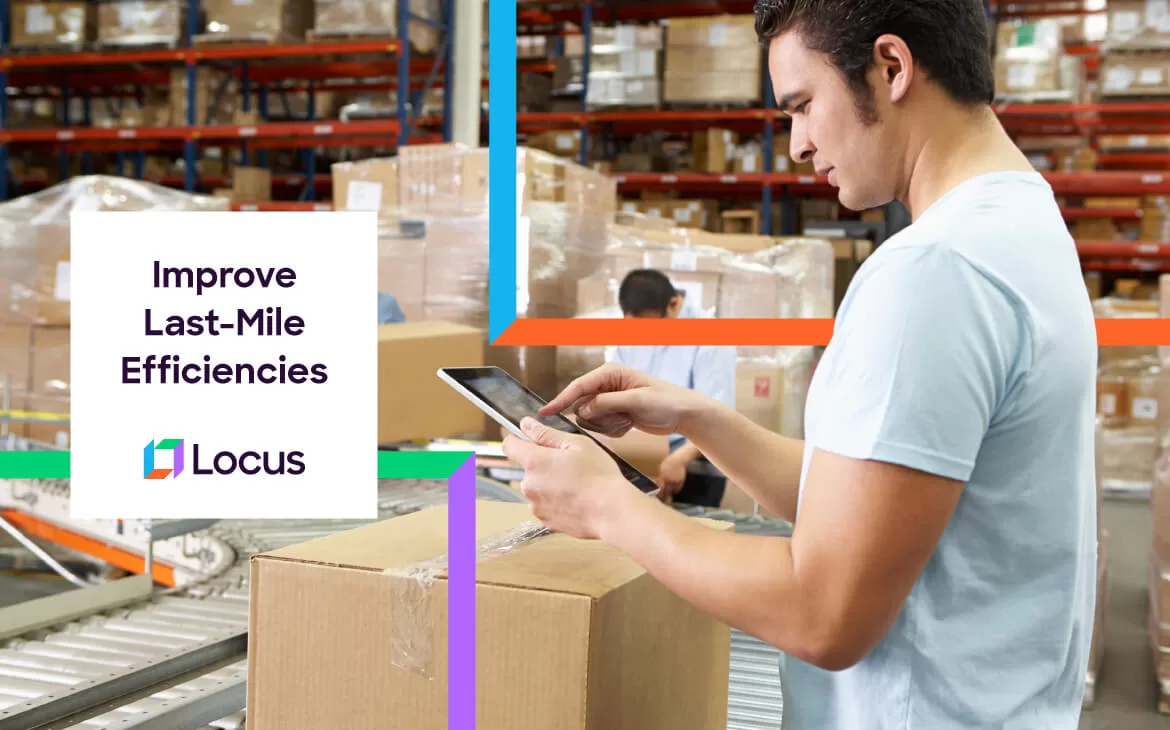Blog, General, Last Mile Delivery Optimization, Route Optimization
How Implementing a Logistics Dispatch Software Can Improve Your Last-Mile Efficiencies
Feb 15, 2022
8 mins read

The COVID-19 pandemic has resulted in a sudden surge in customer orders for home deliveries. Fleets are witnessing irregular fluctuations in the volume of orders, and it has made overall dispatch planning more difficult than usual. Ineffective planning usually brings inefficiencies in last-mile delivery that brings down delivery standards. Here are some last-mile delivery challenges often faced by dispatchers and logistics planners.
- Rising last-mile delivery costs
- Poor logistics visibility
- Inaccurate calculation of Expected Time of Arrival (ETA)
- Inadequate route planning
- Delayed deliveries
- Usage of outdated delivery tools and technologies
- Failed and missed deliveries
Ideally, customers want the cheapest and quickest deliveries at the last-mile. According to studies, last-mile deliveries are a time-consuming and expensive process in the supply chain that accounts for 53% of the total cost of shipping. Every added inefficiency can make last-mile deliveries costlier. Hence, maintaining and improving last-mile efficiency has become critical for brands in a post-covid scenario.
What is last-mile efficiency?
Last-mile efficiency is making the best use of available resources and optimizing the delivery performance at the last-mile, thereby minimizing costs. It means that a fleet utilizing its fullest capacity has, on average, traveled the minimum-possible distance and made a maximum number of on-time deliveries within a given time period.
Efficiency in the last-mile encompasses all aspects, right from solving the vehicle routing problem to interacting with the final customer.
Why should you focus on improving last-mile efficiency?
Last-mile efficiency is that one thin line that differentiates businesses with a reputation for providing exceptional customer experience from those providing a poor one. There are many reasons why you should focus on last-mile efficiency:
- Minimize the time taken to deliver products
- Improve customer satisfaction with top-notch delivery experiences
- Counter delivery complexities in the last-mile
- Minimize fuel consumption and reduce carbon emissions
- Reduce delivery delays
Implementing a dispatch software can improve your last-mile efficiency

The primary factor behind increasing delivery profitability is the last-mile efficiency. Lately, more and more businesses have started enhancing their last-mile capabilities to cater to the new demands of customers. An intelligent and intuitive dispatch software can help you improve last-mile efficiencies and meet the new delivery expectations of customers. Find out how dispatch software can improve your last-mile efficiency.
Facilitating effective time slot management
What do customers want?
The delivery of their products at their preferred time slots.
The challenge
If manually done, the effective management of time slots for deliveries is highly resource intensive. Some enterprises do not provide that option to customers as they think it adds to the workload of their staff with few returns. The mismanagement of time slots lead to delivery delays, making customers frustrated.
How does dispatch software improve your time slot management processes?
Dispatch software helps businesses automate job scheduling and task assignment for their diverse fleet within a few minutes. It ensures that all the delivery related information is ready for the driver’s consumption in advance. It enables fleet managers to reduce delivery delays and reattempted deliveries, thereby minimizing costs and errors.
Tracking deliveries
What do customers want?
Staying informed about delivery statuses in real-time
The challenge
One of the other biggest challenges that businesses face is the inability to provide a seamless tracking experience to customers. Modern customers expect more than a static tracking number today. They want an exceptional, real-time tracking experience with accurate ETAs, SMS alerts, email notifications, and live driver locations.
How does dispatch software enable real-time tracking of deliveries?
Dispatch software helps customers to track the current status of their delivery orders on a tracking page. It enables them to quickly reschedule deliveries, pass on additional delivery instructions to drivers, and provide real-time feedback on deliveries.
By providing real-time tracking to customers, businesses can reduce the huge costs involved with customer support services. This helps them prepare for home deliveries, thereby minimizing the chances for failed and missed deliveries.
Manage rescheduled deliveries effectively
What do customers want?
The ability to reschedule deliveries and set alternate delivery locations in case they are not available at home.
The challenge
With businesses managing huge volumes of orders daily, a few hundred customers rescheduling deliveries do cause a huge burden as it disrupts pre-planned routes and schedules.
Dispatchers find it difficult to manage the rescheduled deliveries and fulfill their new on-time delivery promises. As issues like driver shortage or increasing vehicle downtime troubles them, this creates a huge workload on the available resources. Rescheduled deliveries also add to total last-mile delivery costs.
How does dispatch software bring flexibility to vehicle routing and scheduling?
Managing last-mile efficiency becomes a headache when customers reschedule deliveries. Dispatch software helps enterprise businesses to schedule thousands of orders with minimal human intervention. It takes numerous constraints into account to calculate the most suitable delivery windows for rescheduled deliveries that do not burden their resources.
Dispatch software has a proper rider performance management system with full visibility into the availability of drivers. It helps fleet managers do capacity planning and workload management if drivers are unavailable due to sick leaves, holidays or day-offs. This enables them to effortlessly manage the scheduled and rescheduled deliveries on any given day.
Build a seamless returns process
What customers want?
An effective and easy way to manage returns
The challenge
Today, returns play a significant role in providing a delightful and comprehensive customer experience. As customers expect an excellent delivery experience and high service levels, businesses are struggling to find an effective way to manage their returns process. High volume of returns make last-mile deliveries even more complex and costly for modern enterprise businesses.
How a dispatch software can smoothen your returns process
Dispatch software helps you cluster your return pickups and dropoffs in a single batch. Its smarter scheduling abilities help you to quickly and effectively schedule routing, and dispatch operations. It generates cost-effective routes that save money, resources and time, thereby reducing your total operational costs of reverse logistics.
Dispatch software also helps in improving your First Attempted Delivery Rates (FADR) and ensures your volume of returns are minimized in the first place. With its improved process efficiency, you can cut down unnecessary last-mile costs and provide an enhanced customer service, thereby increasing the likelihood of repeat purchases.
Improve delivery speeds

What do customers want?
Speedy on-time deliveries of products and multiple last-mile delivery options like same-day delivery, next-day delivery, and on-demand delivery.
The challenge
As customers continue to expect speedy deliveries for their orders, enterprise businesses are struggling to provide quick deliveries without increasing delivery costs. Increasing time window restrictions and traffic congestions make speedy deliveries more difficult to achieve.
How does dispatch software improve your last-mile efficiency?
Dispatch software recommends the most efficient delivery routes in real-time after factoring in constraints like vehicle capacity, traffic, time, location etc. It sends you notifications instantly if there are any updates on traffic that could affect your delivery routes. Its machine learning algorithms improve the route efficiency by constantly learning from on-ground executions.
The optimal routes generated from a dispatch software enables your delivery executives to adhere to their Service Line Agreements (SLAs) and perform multi-drop delivery tasks seamlessly. It analyzes historical delivery performance data and provides insightful delivery metrics that help your stakeholders and management to improve their dispatching strategies.
Dispatch software enables your fleet managers to ensure that there are no overlaps in deliveries by creating distinct delivery zones. Zone-based routing and clustering of orders ensures that two or multiple vehicles do not travel in the same delivery zones. This helps you enable maximum resource utilization on the ground.
Check Out: Territory-Based Route Planning
Conclusion
As last-mile deliveries increasingly turn more complex, every business wants to stay on top of the rapidly changing logistics space. The solution to counter these complexities and inefficiencies in deliveries is by improving the last-mile efficiency. An important step in this direction is investing in a modern and sophisticated last-mile dispatch software.
Dynamic algorithms from Locus’ dispatching software helps enterprise businesses drive last-mile efficiency with minimal human intervention. Its best-in-class dispatching abilities enable them to plan, route, track and dispatch hybrid fleets on a single intuitive platform. It automatically schedules deliveries in real-time and maximizes resource utilization even with dynamic customer demands.
Solve complexities and inefficiencies in the last-mile with Locus Dispatching software, click here to sign up for a demo!

Related Tags:

Blog
Why automation is the next step in your dispatch optimization journey
With an intelligent logistics software, businesses can automate dispatch optimization to improve customer experiences with faster deliveries. Read on to know more.
Read more
Blog
Locus’ Guide to Optimal Last-Mile Order Management System
The year 2020 changed the face of e-commerce. We fell into the pandemic face-first, and consumers who could no longer flock store aisles made a swift move to online shopping. That year alone saw over two billion goods or services sold online, and e-retail sales surpassing $4.2 trillion worldwide. COVID-19 continues to have an impact […]
Read moreMOST POPULAR
EDITOR’S PICKS
SUBSCRIBE TO OUR NEWSLETTER
Stay up to date with the latest marketing, sales, and service tips and news


How Implementing a Logistics Dispatch Software Can Improve Your Last-Mile Efficiencies